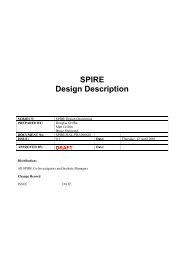SCUBA-2 with FTS and 80K blackbody source
SCUBA-2 with FTS and 80K blackbody source
SCUBA-2 with FTS and 80K blackbody source
Create successful ePaper yourself
Turn your PDF publications into a flip-book with our unique Google optimized e-Paper software.
7. Calculate the NEFDs<br />
Telescope surface large scale rms:<br />
Sky transmission :<br />
Coupling efficiency to telescope :<br />
Modulation efficiency :<br />
Compute the NEFD :<br />
σ := 21⋅μm ηtel := II( 1 − ngap,<br />
1 − ngap)<br />
ηmod ≡<br />
NEFD :=<br />
NEFD 63.799 mJy Hz<br />
−<br />
= ⋅<br />
Note that this is the NEFD per pixel for the conceptual <strong>SCUBA</strong>-2. Of course, it assumes perfect coupling,<br />
i.e. no stray light etc.<br />
For comparison here is the <strong>SCUBA</strong> per -pixel NEFD at<br />
850μm after the Phase I upgrades under excellent<br />
weather:<br />
1<br />
2<br />
( )<br />
skytrans := Trans A, pwv,<br />
ν , Δν<br />
( ) 1<br />
NEP tot<br />
⎛<br />
−16 π<br />
ηmod⋅ηtel⋅Atel⋅tsys exp<br />
2<br />
⋅ σ 2<br />
⋅<br />
λ 2<br />
⋅ ⎜ ⎟⋅Δν⋅skytrans<br />
⎜<br />
⎝<br />
skytrans = 0.829<br />
ηtel = 0.147<br />
⎞<br />
⎟<br />
⎠<br />
NEFD<strong>SCUBA</strong>850 75⋅mJy Hz<br />
−<br />
:= ⋅<br />
( ) 1<br />
This is the surface accuracy rms that should be<br />
rregularly achievable by 2005/6<br />
Note that although we plan not to chop <strong>with</strong> <strong>SCUBA</strong>-2,<br />
we need to subtract a baseline from the data <strong>and</strong> also<br />
flatfield. This will carry noise <strong>and</strong> if we<br />
assume that the noise in the remove baseline <strong>and</strong> "flat<br />
field" procedure is similar to the observation then we<br />
multiply by 2. This is probably a worst case.
















